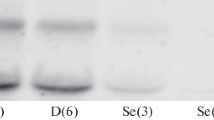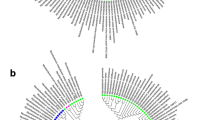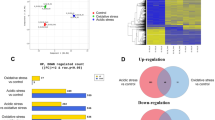Abstract
Chelerythrine (a natural quaternary benzophenanthridine alkaloid) is an extract from the roots of Chelidonium majus with potential antimycobacterial activity. To reveal the possible mechanism of action of chelerythrine against Mycobacterium tuberculosis (M. tuberculosis), commercial oligonucleotide microarrays were used to analyze the genome-wide transcriptional changes triggered by treatment with subinhibitory concentrations of chelerythrine. Quantitative real-time RT-PCR was performed for selected genes to verify the microarray results. We interpreted our microarray data using Agilent software. Analysis of the microarray data revealed that a total of 759 genes were differentially regulated by chelerythrine. Of these, 372 genes were upregulated, and 387 genes were downregulated. Some of the important genes that were significantly regulated are related to different pathways (such as urease), methoxy-mycolic acid synthase, surface-exposed lipids, the heat shock response, and protein synthesis. This genome-wide transcriptomics approach produced the first insights into the response of M. tuberculosis to a chelerythrine challenge.


Similar content being viewed by others
References
Cantrell CL, Franzblau SG, Fischer NH (2001) Antimycobacterial plant terpenoids. Planta Med 67(8):685–694
Chmura SJ, Dolan ME, Cha A, Mauceri HJ, Kufe DW, Weichselbaum RR (2000) In vitro and in vivo activity of protein kinase C inhibitor chelerythrine chloride induces tumor cell toxicity and growth delay in vivo. Clin Cancer Res 6(2):737–742
Jarvis WD, Turner AJ, Povirk LF, Traylor RS, Grant S (1994) Induction of apoptotic DNA fragmentation and cell death in HL-60 human promyelocytic leukemia cells by pharmacological inhibitors of protein kinase C. Cancer Res 54(7):1707–1714
Lenfeld J, Kroutil M, Marsálek E, Slavík J, Preininger V, Simánek V (1981) Anti-inflammatory activity of quaternary benzophenanthridine alkaloids from chelidonium majus. Planta Med 43(2):161–165
Betts JC, McLaren A, Lennon MG, Kelly FM, Lukey PT, Blakemore SJ, Duncan K (2003) Signature gene expression profiles discriminate between isoniazid-, thiolactomycin-, and triclosan-treated Mycobacterium tuberculosis. Antimicrob Agents Chemother 47(9):2903–2913
Boshoff HI, Myers TG, Copp BR, McNeil MR, Wilson MA, Barry CE 3rd (2004) The transcriptional responses of Mycobacterium tuberculosis to inhibitors of metabolism: novel insights into drug mechanisms of action. J Biol Chem 279(38):40174–40184
Yu L, Zhang W, Wang L, Yang J, Liu T, Peng J, Leng W, Chen L, Li R, Jin Q (2007) Transcriptional profiles of the response to ketoconazole and amphotericin B in Trichophyton rubrum. Antimicrob Agents Chemother 51(1):144–153
Yu L, Xiang H, Fan J, Wang D, Yang F, Guo N, Jin Q, Deng X (2008) Global transcriptional response of Staphylococcus aureus to rhein, a natural plant product. J Biotechnol 135(3):304–308
Yu L, Guo N, Meng R, Liu B, Tang X, Jin J, Cui Y, Deng X (2010) Allicin-induced global gene expression profile of Saccharomyces cerevisiae. Appl Microbiol Biotechnol 88(1):219–229
Franzblau SG, Witzig RS, McLaughlin JC, Torres P, Madico G, Hernandez A, Degnan MT, Cook MB, Quenzer VK, Ferguson RM, Gilman RH (1998) Rapid low-technology MIC determination with clinical, Mycobacterium tuberculosis isolates by using the microplate Alamar Blue assay. J Clin Microbiol 36(2):362–366
Jiménez-Arellanes A, Meckes M, Ramírez R, Torres J, Luna-Herrera J (2003) Activity against multidrug-resistant Mycobacterium tuberculosis in mexican plants used to treat respiratory diseases. Phytother Res 17(8):903–908
Slayden RA, Knudson DL, Belisle JT (2006) Identification of cell cycle regulators in Mycobacterium tuberculosis by inhibition of septum formation and global transcriptional analysis. Microbiology 152(6):1789–1797
Micklinghoff JC, Breitinger KJ, Schmidt M, Geffers R, Eikmanns BJ, Bange FC (2009) Role of the transcriptional regulator RamB (Rv0465c) in the control of the glyoxylate cycle in Mycobacterium tuberculosis. J Bacteriol 191(23):7260–7269
Liu TT, Lee RE, Barker KS, Lee RE, Wei L, Homayouni R, Rogers PD (2005) Genome-wide expression profiling of the response to azole, polyene, echinocandin, and pyrimidine antifungal agents in Candida albicans. Antimicrob Agents Chemother 49:2226–2236
Clemens DL, Lee BY, Horwitz MA (1995) Purification, characterization, and genetic analysis of Mycobacterium tuberculosis urease, a potentially critical determinant of host–pathogen interaction. J Bacteriol 177(19):5644–5652
Kim JK, Mulrooney SB, Hausinger RP (2005) Biosynthesis of active Bacillus subtilis urease in the absence of known urease accessory proteins. J Bacteriol 187(20):7150–7154
Marri PR, Bannantine JP, Golding GB (2006) Comparative genomics of metabolic pathways in Mycobacterium species: gene duplication, gene decay and lateral gene transfer. FEMS Microbiol Rev 30(6):906–925
Phadnis SH, Parlow MH, Levy M, Ilver D, Caulkins CM, Connors JB, Dunn BE (1996) Surface localization of Helicobacter pylori urease and heat shock protein homolog requires bacterial autolysis. Infect Immun 64(3):905–912
Bore E, Langsrud S, Langsrud Ø, Rode TM, Holck A (2007) Acid-shock responses in Staphylococcus aureus investigated by global gene expression analysis. Microbiology 153(Pt 7):2289–2303
Dubnau E, Chan J, Raynaud C, Mohan VP, Lanéelle MA, Yu K, Quémard A, Smith I, Daffé M (2000) Oxygenated mycolic acids are necessary for virulence of Mycobacterium tuberculosis in mice. Mol Microbiol 36(3):630–637
Camacho LR, Raynaud C, Constant P, Laneelle MA, Triccas JA, Gicquel B, Cox JS, Chen B, McNeil M, Jacobs WR Jr (1999) Identification of a virulence gene cluster of Mycobacterium tuberculosis by signature-tagged transposon mutagenesis. Mol Microbiol 34:257–267
Camacho LR, Constant P, Raynaud C, Laneelle MA, Triccas JA, Gicquel B, Daffé M, Guilhot C (2001) Analysis of the phthiocerol dimycocerosate locus of Mycobacterium tuberculosis. evidence that this lipid is involved in the cell wall permeability barrier. J Biol Chem 276(23):19845–19854
Cox JS, Chen B, McNeil M, Jacobs WR Jr (1999) Complex lipid determines tissue-specific replication of Mycobacterium tuberculosis in mice. Nature 402(6757):79–83
Domenech P, Reed MB, Barry CE 3rd (2005) Contribution of the Mycobacterium tuberculosis MmpL protein family to virulence and drug resistance. Infect Immun 73(6):3492–3501
Nikaido H, Vaara M (1985) Molecular basis of bacterial outer membrane permeability. Microbiol Rev 49(1):1–32
Stewart GR, Wernisch L, Stabler R, Mangan JA, Hinds J, Laing KG, Young DB, Butcher PD (2002) Dissection of the heat-shock response in Mycobacterium tuberculosis using mutants and microarrays. Microbiology 148(Pt 10):3129–3138
Cunningham AF, Spreadbury CL (1998) Mycobacterial stationary phase induced by low oxygen tension: cell wall thickening and localization of the 16-kilodalton a-crystallin homolog. J Bacteriol 180(4):801–808
Yuan Y, Crane DD, Barry CE 3rd (1996) Stationary phase-associated protein expression in Mycobacterium tuberculosis: function of the mycobacterial α-crystallinhomolog. J Bacteriol 178(15):4484–4492
Narberhaus F (2002) Alpha-crystallin-type heat shock proteins: socializing minichaperones in the context of a multichaperone network. Microbiol Mol Biol Rev 66(1):64–93
Pang X, Howard ST (2007) Regulation of the α-Crystallin gene acr2 by the MprAB two-component system of Mycobacterium tuberculosis. J Bacteriol 189(17):6213–6221
Stewart GR, Newton SM, Wilkinson KA, Humphreys IR, Murphy HN, Robertson BD, Wilkinson RJ, Young DB (2005) The stress-responsive chaperone α-crystallin 2 is required for pathogenesis of Mycobacterium tuberculosis. Mol Microbiol 55(4):1127–1137
Carter AP, Clemons WM, Brodersen DE, Morgan-Warren RJ, Wimberly BT, Ramakrishnan V (2000) Functional insights from the structure of the 30S ribosomal subunit and its interactions with antibiotics. Nature 407(6802):340–348
Dennis PP (1976) Effects of chloramphenicol on the transcriptional activities of ribosomal RNA and ribosomal protein genes in Escherichia coli. J Mol Biol 108(3):535–546
Timm J, Post FA, Bekker LG, Walther GB, Wainwright HC, Manganelli R, Chan WT, Tsenova L, Gold B, Smith I, Kaplan G, McKinney JD (2003) Differential expression of iron-, carbon-, and oxygen-responsive mycobacterial genes in the lungs of chronically infected mice and tuberculosis patients. Proc Natl Acad Sci USA 100:14321–14326
McKinney JD, Höner zu Bentrup K, Muñoz-Elías EJ, Miczak A, Chen B, Chan WT, Swenson D, Sacchettini JC, Jacobs WR Jr, Russell DG (2000) Persistence of Mycobacterium tuberculosis in macrophages and mice requires the glyoxylate shunt enzyme isocitrate lyase. Nature 406:735–738
Karakousis PC, Yoshimatsu T, Lamichhane G, Woolwine SC, Nuermberger EL, GrossetJ Bishai WR, Bishai J (2004) Dormancy phenotype displayed by extracellular Mycobacterium tuberculosis within artificial granulomas in mice. J Exp Med 200(5):647–657
Fisher MA, Plikaytis BB, Shinnick TM (2002) Microarray analysis of the Mycobacterium tuberculosis transcriptional response to the acidic conditions found in phagosomes. J Bacteriol 184(14):4025–4032
Grassi M, Volpe E, Colizzi V, Mariani F (2006) An improved, real-time PCR assay for the detection of GC-rich and low abundance templates of Mycobacterium tuberculosis. J Microbiol Methods 64(3):406–410
Acknowledgments
This work was supported by Important National Science, Technology Specific Projects (2008ZX10301), the Specialized Research Fund for the Doctoral Program of Higher Education (SRFDP) (No. 200801831051), the National Nature Science Foundation of China (No. 30871889), the Fund for Science and Technology Development of the Jilin Province, China (No. 200705233), and the Fundamental Research Funds for the Central Universities.
Conflict of interest
The authors declare that they have no conflict of interest.
Author information
Authors and Affiliations
Corresponding authors
Additional information
Junchao Liang, Fanli Zeng, and Aizhen Guo contributed equally to this work.
Electronic supplementary material
Below is the link to the electronic supplementary material.
Rights and permissions
About this article
Cite this article
Liang, J., Zeng, F., Guo, A. et al. Microarray Analysis of the Chelerythrine-Induced Transcriptome of Mycobacterium tuberculosis . Curr Microbiol 62, 1200–1208 (2011). https://doi.org/10.1007/s00284-010-9837-5
Received:
Accepted:
Published:
Issue Date:
DOI: https://doi.org/10.1007/s00284-010-9837-5




